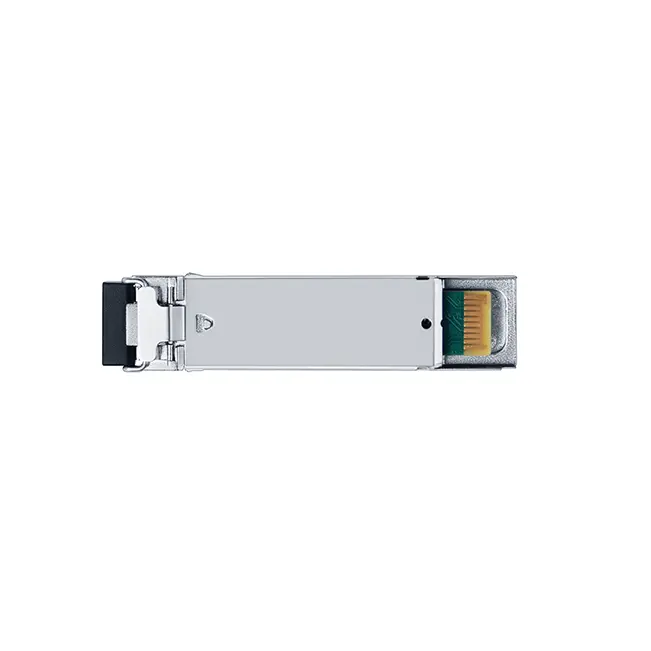
GearLink's gigabit optical transceiver GCS3L0C31 is used in Gigabit Ethernet, dual-channel, and bidirectional transmission synchronous optical network (SONET). SFP 1.25 g 1310nm 10km transceiver conforms to SFP multi-source protocol and SFF-8472, with digital diagnostic monitoring(DDM) function. The package of GCS3L0C31 is SFP with LC interface, the rate is 1.25G, the optical wavelength is 1310NM, and the maximum transmission distance is 10KM.
| GLC-LH-SM | LH SMF 1310nm 10km SFP |
| GLC-GE-DR-LX | 1000BASE-LX-SMF 1310nm 10km SFP/100BASE |
| WS-G5486 | 1000BASE-LX SMF 1310nm 10km SFP |
| GLC-LX-SM-RGD | 1000BASE-LX SMF 1310nm 10km GBIC |
| SFP-GE-L | LH SFP |
| GLC-LH-SMD | 1000BASE-LX |
| SRX-SFP-1GE-LX-ET | 1000BASE-LX SMF 1310nm 10km Extended Temperature SFP |
| E1MG-LX-OM-T | 1000BASE-LX SMF 1310nm 10km DDM Industrial SFP |
| 331-5309 | 1000BASE-LX SMF 1310nm 10km DDM SFP |
| MC3208011-LX | 1000BASE-LX SFP 1310nm 10km |
| JD118A | 1000BASE-SX SFP 850nm 550m |
| J4859D | 1000BASE-LX SFP 1310nm 10km |
| J4859C | 1000BASE-LX SMF 1310nm 10km SFP |
| J4859B | 1000BASE-LX SMF 1310nm 10km SFP |
| J4859A | 1000BASE-LX SMF 1310nm 10km SFP |
| SFP-GE-LX-SM1310 | 1000BASE-LX 1310nm 10km SFP |
| SFP-GE-LX-SM1310-A | 1000BASE-LX SFP 1310nm 10km |
| XCVR-A10Y31 | 1000BASE-LX SFP 1310nm 10km |
| NTTP06CFE6 | 1000BASE-LX SFP 1310nm 10km |
| NTTP01CF | 1000BASE-LX SFP 1310nm 10km |
| XCVR-010M31 | 1000BASE-LX SFP 1310nm 10km |
| XCVR-010Y31 | 1000BASE-LX SFP 1310nm 10km |
Parameter | Symbol | Unit | Min | Max |
Storage Temperature Range | Ts | oC | -40 | +85 |
Relative Humidity | RH | % | 5 | 95 |
Power Supply Voltage | Vcc | V | -0.5 | +4 |
Parameter | Symbol | Unit | Min | Typ | Max |
Case Operating Temperature Range | Tc | oC | -10 | 70 | |
Power Supply Voltage | Vcc | V | 3.135 | 3.3 | 3.465 |
Data rate | Gb/s | - | 1.25/1.0625 | - |


ER generally refers to the transmission distance of 40km.
Wuhan Gearlink Technology Co., Ltd. SFP optical transceiver mainly has the following categories:
According to working wavelength: 850nm, 1310nm, 1550nm
Classified by mode: single-mode, multi-mode
According to transmission distance: short distance, medium distance, long distance
It can also be classified by single fiber and dual fiber, and can be classified by interface such as LC interface, SC interface and so on. These are relatively common divisions.
The SFP optical transceiver has a 100M rate and a 1000M rate. The 100M rate transceiver can be inserted into the 100M port and the Gigabit port for normal use. The actual use rate is 100M, and it can be inserted into the 10G port, but it cannot be used normally. Gigabit optical transceiver s can be inserted into 100M ports, 1000M ports and 10G ports. The usage rate is Gigabit, and the rate of the peer optical transceiver only needs to match the actual usage rate of the transceiver . But in general, the Gigabit optical transceiver will be inserted into the Gigabit port of the switch, neither the port of the switch nor the rate of the optical transceiver will be wasted. The specific usage method still needs to be combined with the usage scenario.
The differences between single-mode and multi-mode Gigabit optical transceiver s are as follows:
①The working wavelength is different: the working wavelength of gigabit multi-mode optical transceiver s is mostly 850nm, and the working wavelengths of gigabit single-mode optical transceiver s are mostly 1310nm and 1550nm;
②The transmission distance is different: the transmission distance of the gigabit multi-mode optical transceiver is 550 meters, and the transmission distance of the gigabit single-mode optical transceiver can reach more than 100 kilometers;
③The scope of application is different. Because the transmission distance of single-mode and multi-mode optical transceiver s is different, their application scope is also different. Single-mode optical transceiver s are suitable for long-distance trunk transmission and metropolitan area network construction, while multi-mode optical transceiver s are suitable for internal transmission in data centers
SFP optical transceiver s can be connected to fiber optic transceivers. The fiber optic transceiver has an optical port, which can be inserted into an optical transceiver . Some fiber optic transceivers also integrate optical transceivers.
SM means single mode. Generally speaking, the transmission distance is greater than 2km. The wavelengths are 1310nm, 1490nm, 1550nm.